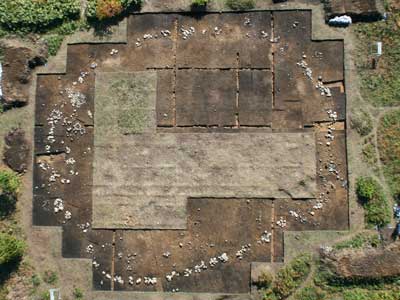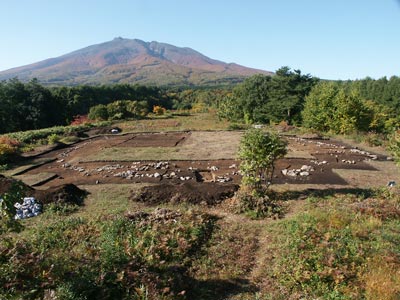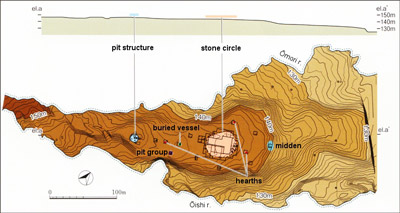Ōmori Katsuyama:
A half century after its discovery, a stone circle is re-investigated.
The surrounding area is seen to have been a ceremonial site.

Stone circle seen from above |

Spouted vessel found in the refuse midden |

Feature made with a buried vessel | |
Ōmori Katsuyama Site, Hirosaki City, Aomori Prefecture
A stone circle built at a spot with a splendid view
Ōmori Katsuyama is the site of a Final Jōmon stone circle lying at the base of the northeast side of Mt. Iwaki, the premier mountain of the Tsugaru region, in the western part of Aomori prefecture. Located atop a tableland, which lies between the Ōmori river to the north and the Ōishi river to the south, and extends to the northeast at 130-150 m in elevation, the Tsugaru plain can be seen from the site spreading to the east, with the Hakkōda mountain range strung out in the distance.
The site was investigated from 1959-61, with the stone circle and a large pit structure being found and then preserved, and nearly a half century after the discovery, a re-investigation was conducted from 2006.
Used as a ceremonial site?
The stone circle is shaped as an oval that is long in the north-south direction, approximately 49 m north-south by 39 m east-west, from the first half of the Final Jōmon (about 3,000 years ago), made with more than 70 stone arrangements that were placed after the top of the tableland was leveled, and further filling and ground preparations carried out. On average, over 10 stones were used for each arrangement, with more than 1,000 stones used in the stone circle as a whole. The bulk of the stones are rocks of pyroxene andesite around 50 cm in diameter, taken from the rivers flowing on both sides of the tableland, although among them are large stones nearly 1 m in size, as well as worked stone objects of unknown use.
At present no features such as burial pits have been found beneath the stone arrangements, but a refuse midden of the same period, stone hearths, and a feature made with a buried vessel have been found in the vicinity, and it appears that the area was used as some kind of ceremonial site.
Built 1,000 years past the peak?
As exemplified by the Ōyu stone circle, a designated Special Historic Site in Akita prefecture, stone circles were distributed around the first half of the Late Jōmon (ca 4,000 years ago), centering on the area from southern Hokkaido to the northern Tōhoku region. But the Ōmori Katsuyama stone circle is about 1,000 years newer than these, an extremely rare example nearly without parallel nationwide. (Iwai Kōsuke)
 The stone circle and Mt. Iwaki
The stone circle and Mt. Iwaki 
